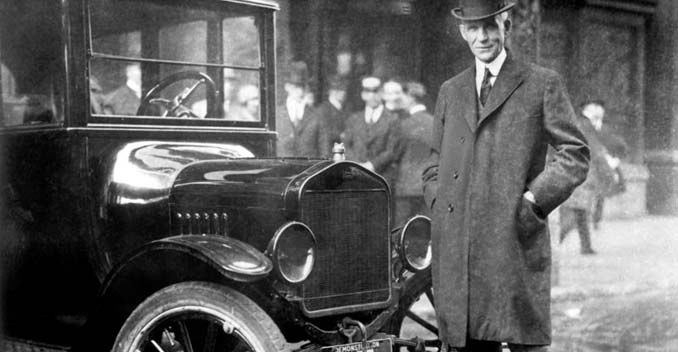The Internal Combustion Engine and Early Gas-Powered Cars
Many history books say that the automobile was invented by either Gottlieb Daimler or Karl Benz because both Daimler and Benz invented highly successful and practical gasoline-powered vehicles that ushered in the age of modern automobiles. Daimler and Benz invented cars that looked and worked like the cars we use today.
An internal combustion engine is any engine that uses the explosive combustion of fuel to push a piston within a cylinder – the piston's movement turns a crankshaft that then turns the car wheels via a chain or a drive shaft. The different types of fuel commonly used for car combustion engines are gasoline (or petrol), diesel, and kerosene.
A brief outline of the history of the internal combustion engine includes the following highlights:
- 1680 – Dutch physicist, Christian Huygens designed (but never built) an internal combustion engine that was to be fueled with gunpowder.
- 1858 – Belgian-born engineer, Jean Joseph Étienne Lenoir invented a double-acting, electric spark-ignition internal combustion engine fueled by coal gas.
- 1876 – Nikolaus August Otto invented a successful four-stroke engine, known as the "Otto cycle".
- 1885 – Gottlieb Daimler invented what is often recognized as the prototype of the modern gas engine – with a vertical cylinder, and with gasoline injected through a carburetor.
- 1886 – On January 29, Karl Benz received the first patent for a gas-fueled car.
- 1889 – Daimler built an improved four-stroke engine with mushroom-shaped valves and two V-slant cylinders.
- 1890 – Wilhelm Maybach built the first four-cylinder, four-stroke engine.
Engine design and car design were integral activities, almost all of the engine designers mentioned above also designed cars, and a few went on to become major manufacturers of automobiles. Daimler founded the Daimler Motoren-Gesellschaft in 1890 to manufacture his designs. Eleven years later, Wilhelm Maybach designed the Mercedes automobile.
The First Mass Producers of Cars – The Assembly Line
By the early 1900s, gasoline cars started to outsell all other types of motor vehicles. The market was growing for economical automobiles and the need for industrial production was pressing.
The first car manufacturers (builders of entire motor vehicles for sale and not just engine inventors who experimented with car design to test their engines) in the world were French: Panhard & Levassor (1889) and Peugeot (1891). Rene Panhard and Emile Levassor built their first car in 1890 using a Daimler engine.
The first automobile to be mass produced in the United States was the 1901, Curved Dash Oldsmobile, built by the American car manufacturer Ransome Eli Olds (1864-1950). Olds invented the basic concept of the assembly line and started the Detroit area automobile industry.

| American car manufacturer, Henry Ford (1863-1947) invented an improved assembly line and installed the first conveyor belt-based assembly line in his car factory in Ford's Highland Park, Michigan plant, around 1913-1914. |
The assembly line reduced production costs for cars by reducing assembly time. Ford made his first car, called the «Quadricycle» in June, 1896.
However, success came after he formed the Ford Motor Company in 1903. He introduced the Model T in 1908 and it was a success. After installing the moving assembly lines in his factory in 1913, Ford became the world's biggest car manufacturer. By 1927, 15 million Model Ts had been manufactured.
VI. Comprehension check.
Activity 1. Do the false / true activity:
1. The automobile was not invented in a single day by a single inventor.
2. Nicolas Joseph Cugnotbuilt the Benz Patent-Motorwagen in 1886.
3. The very first self-propelled road vehicle was a military tractor invented by French engineer and mechanic, Henry Ford.
4. In the late 1800s, the United States and Germany were the first nations to support the widespread development of electric vehicles.
5. The years 1899 and 1900 were the high point of electric cars in America, as they outsold all other types of cars.
6. Electric vehicles had many disadvantages over their competitors in the early 1900s. They had the vibration, smell, and made much noise.
7. By the early 1900s, gasoline cars started to outsell all other types of motor vehicles.
8. The first car manufacturers (builders of entire motor vehicles for sale and not just engine inventors who experimented with car design to test their engines) in the world were German.
9. American car manufacturer, Henry Ford, invented an improved assembly line and installed the first conveyor belt-based assembly line in his car factory in Ford's Highland Park, Michigan plant, around 1913-1914.
10. The assembly line increased production costs for cars by reducing assembly time.
Activity 2. Look through the text 1A carefully. Then complete the following to make suitable sentences according to the meaning of the text:
1. The word automobile is a classical compound derived from ____.
2. The history of the automobile is very rich and dates back to ____.
3. But it is the year _____ which is regarded as the birth year of the modern car. In that year, German inventor Karl Benz built the Benz Patent-Motorwagen.
4. In 1769, the very first self-propelled road vehicle was _____ invented by French engineer and mechanic, Nicolas Joseph Cugnot.
5. Steam engines powered cars by __________________________.
6. Electric cars used _____________________________________________.
7. Electric vehicles had many advantages over their competitors in the early 1900s. They __________________________________.
8. The 60s and 70s saw a need for alternative-fueled vehicles to reduce ____.
9. An internal combustion engine is any engine that _____________.
10. The different types of fuel commonly used for car combustion engines are _____.
11. In 1890 Wilhelm Maybach built the first _________________.
12. American car manufacturer, Henry Ford (1863-1947) invented an improved _____.
VII. Discussion.